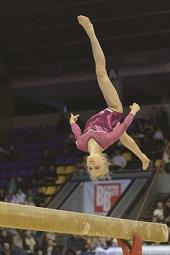
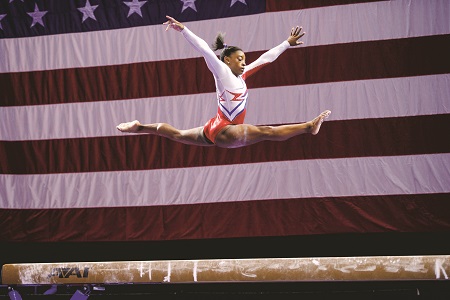
Another unique quality that destinations and planners alike love about it: “Gymnastics is one of the least challenging sports to host,” says Marissa Werner, sports and entertainment sales manager for Visit Milwaukee, home of the annual Midwest Twisters Gymnastics Invitational at the downtown Wisconsin Center convention facility.
Just about all gymnastics requires is a venue within safe walking distance of hotels, restaurants and other attractions. It also needs ceilings with heights in excess of 20 feet, plenty of floor space and room for portable or permanent bleacher seating. Typically, that venue is a convention center or an arena, and the host organization provides equipment, judges and podiums. With the exception of the Olympics and the Kellogg’s Tour of Gymnastics Champions, the sport does not draw many spectators outside of family and friends, but competitions often last the better part of a week.
In addition to many national-level events overseen by USA Gymnastics, the Indianapolis-based national governing body sanctions approximately 4,000 events per year run by local clubs.
“What we’re trying to do nationally is reach down to all of our members and let them know how they can partner with convention and visitors bureaus to make these events happen,” says Ron Galimore, USA Gymnastics’ chief operating officer and a member of the U.S. Olympic men’s gymnastics team in 1980, the year 65 countries, including the United States, boycotted the Games. “For us, it’s about finding the right fit with the right city and the right strategic partners.”
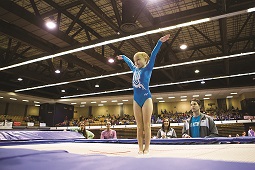
Most people, if they know gymnastics at all, are familiar with artistic gymnastics. Divided into men’s and women’s categories, they include the traditional events that get plenty of primetime coverage during the Olympics. Men compete in six events: Floor Exercise, Pommel Horse, Still Rings, Vault, Parallel Bars and High Bar. Women, meanwhile, compete in four events: Vault, Uneven Bars, Balance Beam and Floor Exercise.
Another gymnastics discipline that is also an Olympic sport (since 2000) is trampoline, which is often mentioned with tumbling (a demonstration event at the 1996 and 2000 Games). Trampoline and tumbling consists of four events: individual and synchronized tumbling, double-mini trampoline and tumbling. Trampoline competitions were sold out at the 2012 Olympics in London, where Savannah Vinsant became the first U.S. trampolinist to qualify for an Olympic finals. She finished in sixth place. “It’s very popular to watch,” Galimore says, adding that Vinsant’s showing in London gave the sport a bounce in this country.

Rhythmic gymnastics, a third Olympic sport, combines acrobatics with dance and apparatus that include balls, ribbons, hoops, rope and clubs. The emphasis is on aesthetics more than athleticism.
Acrobatic gymnastics, on the other hand, showcases athletics and balance as participants in groups of two, three or four toss their partners in the air and create intricate pyramids during dynamic, high-energy performances.
The fifth discipline, dubbed Gymnastics for All, also is the most destination-friendly one — but it is primarily centralized in Europe. With a focus on participation instead of competition, GfA emphasizes fitness, movement and health for all ages and can takes place at multiple venues in a given city. “It really takes over a city and the surrounding areas,” Galimore says. “We’ve toyed with the idea of bringing Gymnastics for All to the United States, but we’re not there yet.”
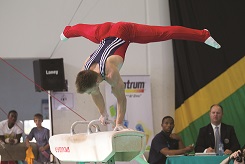
Even without Gymnastics for All, there are enough gymnastics activities in the four other disciplines to keep convention centers around the country busy during traditionally slower times of the year. And the keys to success, say destinations, is to create a partnership with a successful gymnastics club affiliated with USA Gymnastics or other organizations. In fact, this type of mutually beneficial business relationship can exponentially increase the likelihood of bringing in a major gymnastics event.
“Many USA Gymnastics events work through a local USA Gymnastics sanctioned club for coordination and execution of the competition,” says Jackie Lozano-Payne, a sales manager for VisitNorfolk in Virginia. “For other event owners, the most important thing is the local organizing committee’s participation, as well as the quantity and quality of the competition facilities and practice facilities.”
Hampton Roads, the metropolitan area that includes Norfolk and several other cities located at the mouth of the Chesapeake Bay, will host the AAU Junior Olympics — including gymnastics events —in late July and early August of 2015.
Go all the way across the country and you’ll find another example of a city partnering with a club. In Oakland, California, the Gold Country Classic men’s and women’s gymnastics competition has been held at the Oakland Marriott City Center and Oakland Convention Center for the past for years.
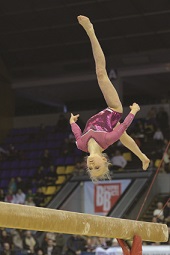
Oakland is bidding on regional and national USA Gymnastics events, too, and O’Shea — who points out that Oakland is “near San Francisco without the pricing of San Francisco” — feels confident. “I’m sure we’ll eventually get something from them,” he says.
Host Clubs Put in the Hours
Four hundred miles to the south, in Ontario, California, a similar arrangement with the Charter Oak Gliders brings 600 girls to the Ontario Convention Center every February for the Gliders Invitational. As the only venue in the area that can accommodate an event of that size, the convention center offers 70,000 square feet of exhibit hall-turned-competition space. “It’s a very simple process for us,” says Angela Hui, director of sales for the convention center. “But it’s a lot of work for the local host club that has to bring a gymnastics studio into a 70,000-square-foot space.”
Ontario also is working on securing national Junior Olympic events and is partnering with a local club to begin hosting a trampoline and tumbling regional championship at the convention center. “This is brand-new to me,” Hui says. “I had never even heard of that event until a local promoter called me.”
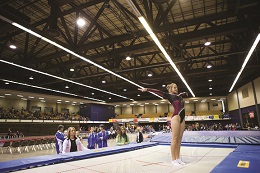
The Midwest Twisters gymnastics club in Milwaukee, Wisconsin, has scored a 10 with a most unlikely invitational sponsor: Hal’s Harley-Davidson in nearby New Berlin. In 2014, approximately 1,800 gymnasts from seven states competed in the Midwest Twisters Hal’s Harley-Davidson Gymnastics Invitational, held every President’s Day weekend at the Wisconsin Center. As the invitational’s permanent home, the venue offers 90,000 square feet of competition space in two exhibit halls and opens up the festivities to the public, but that’s not even the city’s largest gymnastics competition.
Two years ago, the YMCA of Metropolitan Milwaukee brought the 2012 YMCA Gymnastics National Championships to Milwaukee. About 4,000 athletes competed in all four of the Wisconsin Center’s exhibit halls, which collectively span 180,000 square feet. Because the event was held in late June and coincided with Summerfest, Milwaukee’s renowned 11-day music festival held on the shores of Lake Michigan, the gymnasts were invited to participate in a parade around the grounds on Summerfest’s opening day.
“It’s all about giving them a great experience, and because the YMCA Nationals was such a great success, there’s interest in bringing it back here,” Visit Milwaukee’s Werner says, adding that the economic impact from that single event was $3.5 million.
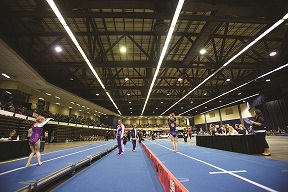
Like Milwaukee, Alpharetta, Georgia, is looking to establish a greater gymnastics foothold. “We have had mostly local events happen, but will host an upcoming event that will draw out-of-town guests,” says Caitlyn Blizzard, director of communications for the Alpharetta Convention and Visitors Bureau, referring to “The Showdown,” a USA Gymnastics-sanctioned meet hosted by All-Around Gymnastics to be held at Alpharetta High School in October.
“We are anticipating up to 400 participants, along with an additional 800 spectators. Some of these participants will come from the immediate metro Atlanta area, and the organizers are working to bring in more participants from all over Georgia and the Southeast.”
“The Showdown” will serve as an example of how large-scale gymnastics competitions can be hosted in venues other than convention centers or arenas. Alpharetta High boasts more than 2,000 students, a national profile and a large gymnasium. “This is not the first event of this magnitude held at AHS,” Blizzard says. “We have a partnership with the high school that allows us you use their facilities to host sporting events whenever they are not being used by students.”
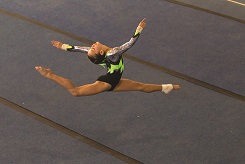
Collegiate facilities also are ideal venues for gymnastics competitions. North Carolina State University’ Reynolds Coliseum — home to N.C. State’s gymnastics program — has hosted NCAA Regionals in 2004, 2009 and 2012, and will do so again in 2018. Regional USA Gymnastics events also have been held at the arena.
Although the 65-year-old coliseum will be closed for renovations between March 2015 and August 2016, the facility will remain a destination point for gymnastics competitions upon reopening, according to Adina Stock, N.C. State’s assistant athletic director for operations.
“Reynolds is a great smaller venue that allows for ample space to host NCAA gymnastics meets, as well as USA Gymnastics; we have more than enough floor room. Seating with the current Reynolds gives us over 7,000 seats. With the new Reynolds, we will have air conditioning, which currently we do not have, and we will become a smaller venue of 5,000 seats to better suit the events that occur in Reynolds — especially gymnastics, which has 2,000 to 4,000 spectators, depending on the competition.”
Creating a Vacation Vibe
In May, The Wildwoods Convention Center in New Jersey hosted the United States Association of Independent Gymnastics Clubs New Jersey State Championships — a first-time event that has already re-upped for May 2015.
“I thought it was going to be a one-and-done,” says John Lynch, the facility’s director of sales and entertainment. “But the backdrop of our convention center is the Atlantic Ocean, and it’s a strong pull. Of all the youth sports events we do, gymnastics, dance, cheerleading and wrestling are the most family-oriented events. Gymnastics participants travel in family units, and they can tie the trip into a family vacation.”
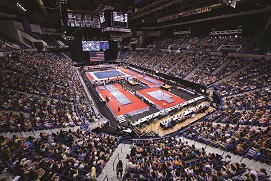
Want Success? Keep Getting ‘Bigger and Better’
Another first-time gymnastics event, the Texas Games hosted by the local club Air Extreme, took place in July at the Lubbock Civic Center. About 600 participants in trampoline, tumbling, double-mini and synchronized trampoline were expected to compete.
Earlier in the year, the civic center welcomed an estimated 1,200 athletes to the USA Gymnastics Trampoline and Tumbling 2014 Region 3 Championships. And the annual Gymnastics Extreme Winter Classic draws 500 or so gymnasts. For all three events, local organizers were key.
Like many other communities, Lubbock officials are seeking to strengthen ties with local clubs to bring in more gymnastics events. “We’re trying to do things bigger and better,” says Scott Harrison, director of sports for the Lubbock Convention and Visitors Bureau. “We will host more.”

